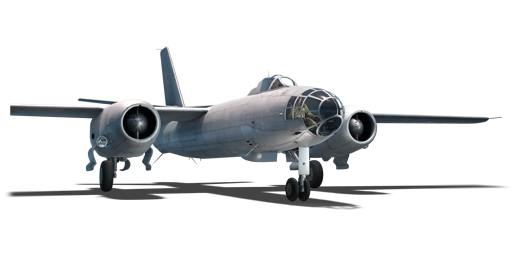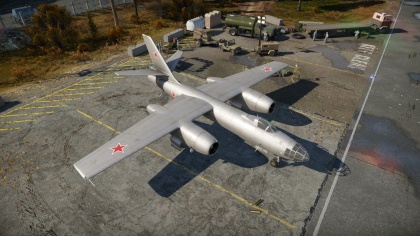Difference between revisions of "IL-28Sh"
Inceptor57 (talk | contribs) (Added devblog link and history) |
(Added disambig notice) |
||
| Line 1: | Line 1: | ||
{{Specs-Card|code=il_28sh}} | {{Specs-Card|code=il_28sh}} | ||
| + | {{Notice|''This page is about the aircraft '''{{PAGENAME}}'''. For the other version, see [[IL-28]]''}} | ||
== Description == | == Description == | ||
| Line 6: | Line 7: | ||
[[File:GarageImage_{{PAGENAME}}.jpg|420px|thumb|left|The '''{{PAGENAME}}''' in the garage]] | [[File:GarageImage_{{PAGENAME}}.jpg|420px|thumb|left|The '''{{PAGENAME}}''' in the garage]] | ||
{{break}} | {{break}} | ||
| − | The '''{{Specs|name}}''' is a Rank {{Specs|rank}} Russian jet bomber {{Battle-rating | + | The '''{{Specs|name}}''' is a Rank {{Specs|rank}} Russian jet bomber {{Battle-rating}}. This aircraft was introduced in [[Update_1.79_"Project_X"|Update 1.79 "Project X"]]. |
== General info == | == General info == | ||
Revision as of 09:39, 16 March 2019
Contents
| This page is about the aircraft IL-28Sh. For the other version, see IL-28 |
Description
The IL-28Sh is a Rank V Russian jet bomber
with a battle rating of 8.0 (AB/RB/SB). This aircraft was introduced in Update 1.79 "Project X".
General info
Flight Performance
| Characteristics | |||||||
|---|---|---|---|---|---|---|---|
| Stock | |||||||
| Max Speed (km/h at ?,000 m) |
Max altitude (meters) |
Turn time (seconds) |
Rate of climb (meters/second) |
Take-off run (meters) | |||
| AB | RB | AB | RB | AB | RB | ||
| ? | ? | 11500 | ??.? | ??.? | ??.? | ??.? | ??? |
| Upgraded | |||||||
| Max Speed (km/h at ?,000 m) |
Max altitude (meters) | Turn time (seconds) | Rate of climb (meters/second) |
Take-off run (meters) | |||
| AB | RB | AB | RB | AB | RB | ||
| ? | ? | 11500 | ??.? | ??.? | ??.? | ??.? | ??? |
Details
| Features | ||||
|---|---|---|---|---|
| Combat flap | Take-off flap | Landing flap | Air brakes | Arrestor gear |
| ✓ | ✓ | ✓ | X | X |
| Limits | ||||
|---|---|---|---|---|
| Wing-break speed (km/h) |
Gear limit (km/h) |
Combat flap (km/h) |
Max Static G | |
| + | - | |||
| 0 | 400 | 600 | ~?? | ~? |
| Optimal velocities | |||
|---|---|---|---|
| Ailerons (km/h) |
Rudder (km/h) |
Elevators (km/h) |
Radiator (km/h) |
| < 500 | < 600 | < 600 | > ??? |
| Compressor (RB/SB) | ||
|---|---|---|
| Setting 1 | ||
| Optimal altitude | 100% Engine power | WEP Engine power |
| 0 m | 2550 kgf | No WEP |
Survivability and armour
- No armour plating
- No armour glazing
- Critical components located at the front of aircraft (fuel, pilot, engine, controls)
- More fuel tanks located in wings near the fuselage
Armaments
Offensive armament
Describe the offensive armament of the aircraft, if any. Describe how effective the cannons and machine guns are in a battle, and also what belts or drums are better to use. If there is no offensive weaponry, delete this subsection.
Suspended armament
Describe the aircraft's suspended armament: additional cannons under the wings, bombs, rockets and torpedoes. This section is especially important for bombers and attackers. If there is no suspended weaponry remove this subsection.
Defensive armament
Defensive armament with turret machine guns or cannons, crewed by gunners. Examine the number of gunners and what belts or drums are better to use. If defensive weaponry is not available, remove this subsection.
Usage in battles
Describe the tactics of playing in an aircraft, the features of using vehicles in a team and advice on tactics. Refrain from creating a "guide" - do not impose a single point of view but give the reader food for thought. Examine the most dangerous enemies and give recommendations on fighting them. If necessary, note the specifics of the game in different modes (AB, RB, SB).
Manual Engine Control
| MEC elements | ||||||
|---|---|---|---|---|---|---|
| Mixer | Pitch | Radiator | Supercharger | Turbocharger | ||
| Oil | Water | Type | ||||
| Not controllable | Not controllable | Not controllable | Not controllable | Separate | Not ontrollable | Not controllable |
Modules
| Tier | Flight performance | Survivability | Weaponry | ||
|---|---|---|---|---|---|
| I | Fuselage Repair | Radiator | |||
| II | Compressor | Airframe | |||
| III | Wings Repair | Engine | |||
| IV | Engine Injection | Cover | |||
Pros and cons
Summarize and briefly evaluate the vehicle in terms of its characteristics and combat effectiveness. Mark its pros and cons in the bulleted list. Try not to use more than 6 points for each of the characteristics. Avoid using categorical definitions such as "bad", "good" and the like - they have a substitution in the form of softer "inadequate", "effective".
Pros:
Cons:
History
Development work on the IL-28Sh (Sh = Shturmovik; attacker) began in 1967 after it became clear that the main fighter-bomber of the Soviet air force, the MiG-15, had insufficient combat loads. As a result of this, Soviet engineers once more began looking into the possibility of converting some IL-28 bombers into attack aircraft. This resulted in the creation of the IL-28Sh, a regular IL-28 modified to fit 12 external pylons suspended underneath the wings. This allowed the IL-28Sh to carry, in addition to its standard internal payloads, a large number of suspended ordnance options ranging from rocket-and gunpods to additional bombs.
Testing of the modified machine began in autumn 1967, showing positive results. However, the way the Soviet high command envisioned to use the aircraft as an attacker contradicted some of the design choices made initially, while the aircraft was still intended to be used as a bomber. To fully utilize the destructive power of its expanded payload options and to avoid premature detection as well as anti-aircraft fire, the IL-28Sh was intended to be used at low to extremely low altitudes (going as low as 60 m). Operating at extremely low altitude like this meant that the crew of the Il-28Sh had to undergo special training in order to acquire the skills needed to use the machine this way. However, the biggest advantage that this kind of low-level flying offered was excellent visibility for both the pilot and bombardier as well as allowing the aircraft to be operated from front-line airfields. Nonetheless, testing also showed that the IL-28Sh wasn’t without its flaws. Not only did the IL-28Sh lack sufficient enough armor protection to be used in this kind of role, but that the risk of losing the crew in an emergency situation was far greater than usually. These severe drawbacks ultimately led to the IL-28Sh being classified as unsuitable for the role of an attack aircraft and the project was shut down soon afterwards. Despite 70 regular IL-28 units being planned to be converted to the attacker version, only a handful of them was actually modified before the project was shut down.
- From Devblog
Media
An excellent addition to the article will be video guides, as well as screenshots from the game and photos.
See also
Links to the articles on the War Thunder Wiki that you think will be useful for the reader, for example:
- reference to the series of the aircraft;
- links to approximate analogues of other nations and research trees.
External links
| USSR jet aircraft | |
|---|---|
| Bereznyak-Isayev | BI |
| Yakovlev | Yak-15 · Yak-15P · Yak-17 · Yak-23 · Yak-28B · Yak-30D · Yak-38 · Yak-38M · Yak-141 |
| Mikoyan-Gurevich | MiG-9 · MiG-9 (l) · MiG-15 · MiG-15bis · MiG-15bis ISh · MiG-17 · MiG-17AS · MiG-19PT |
| MiG-21F-13 · MiG-21PFM · MiG-21S (R-13-300) · MiG-21SMT · MiG-21bis | |
| MiG-23M · MiG-23ML · MiG-23MLD · MiG-27M · MiG-27K | |
| MiG-29 · MiG-29SMT | |
| Lavochkin | La-174 · La-15 · La-200 |
| Sukhoi | Su-9 · Su-11 |
| Su-7B · Su-7BKL · Su-7BMK · Su-17M2 · Su-17M4 · Su-22M3 | |
| Su-24M | |
| Su-25 · Su-25BM · Su-25K · Su-25T · Su-25SM3 · Su-39 | |
| Su-27 · Su-27SM | |
| Su-34 | |
| Ilyushin | IL-28 · IL-28Sh |
| Tupolev | Tu-14T |





